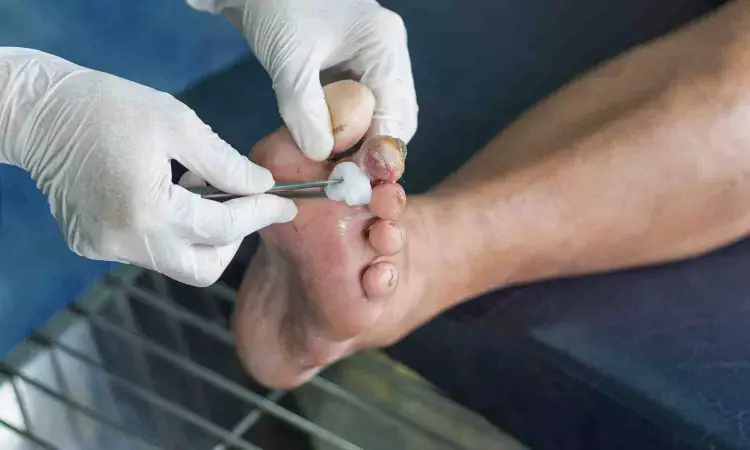- Home
- Medical news & Guidelines
- Anesthesiology
- Cardiology and CTVS
- Critical Care
- Dentistry
- Dermatology
- Diabetes and Endocrinology
- ENT
- Gastroenterology
- Medicine
- Nephrology
- Neurology
- Obstretics-Gynaecology
- Oncology
- Ophthalmology
- Orthopaedics
- Pediatrics-Neonatology
- Psychiatry
- Pulmonology
- Radiology
- Surgery
- Urology
- Laboratory Medicine
- Diet
- Nursing
- Paramedical
- Physiotherapy
- Health news
- Fact Check
- Bone Health Fact Check
- Brain Health Fact Check
- Cancer Related Fact Check
- Child Care Fact Check
- Dental and oral health fact check
- Diabetes and metabolic health fact check
- Diet and Nutrition Fact Check
- Eye and ENT Care Fact Check
- Fitness fact check
- Gut health fact check
- Heart health fact check
- Kidney health fact check
- Medical education fact check
- Men's health fact check
- Respiratory fact check
- Skin and hair care fact check
- Vaccine and Immunization fact check
- Women's health fact check
- AYUSH
- State News
- Andaman and Nicobar Islands
- Andhra Pradesh
- Arunachal Pradesh
- Assam
- Bihar
- Chandigarh
- Chattisgarh
- Dadra and Nagar Haveli
- Daman and Diu
- Delhi
- Goa
- Gujarat
- Haryana
- Himachal Pradesh
- Jammu & Kashmir
- Jharkhand
- Karnataka
- Kerala
- Ladakh
- Lakshadweep
- Madhya Pradesh
- Maharashtra
- Manipur
- Meghalaya
- Mizoram
- Nagaland
- Odisha
- Puducherry
- Punjab
- Rajasthan
- Sikkim
- Tamil Nadu
- Telangana
- Tripura
- Uttar Pradesh
- Uttrakhand
- West Bengal
- Medical Education
- Industry
High Transepidermal Water Loss Predicts Diabetic Foot Ulcer Recurrence, reveals study

A study published in Diabetes Care has found that transepidermal water loss (TEWL) is a strong predictor of diabetic foot ulcer recurrence. Involving over 400 adults, the study revealed that individuals with high TEWL were 2.7 times more likely to experience ulcer recurrence compared to those with low TEWL.
A research team funded by the National Institutes of Health (NIH) has identified a diagnostic aid that has the potential to accurately predict the recurrence of diabetic foot ulcers that appear to be fully healed. By measuring the skin’s barrier function through a process known as trans-epidermal water loss, or TEWL, scientists were able to determine which wounds were more likely to reopen. TEWL measurements are a major factor in burn care, where deep layers of the skin are often damaged. The findings suggest that full restoration of skin barrier function should be incorporated into existing wound treatment standards to ensure complete wound closure and to better identify patients at risk of wound recurrence.
“This study is an important initial step to give clinicians treating diabetic foot ulcers a reliable diagnostic aid for the first time to assess an individual’s risk of ulcer recurrence,” said Teresa Jones, M.D. program director for the Division of Diabetes, Endocrinology, & Metabolic Diseases at NIH’s National Institute of Diabetes, Digestive and Kidney Diseases (NIDDK). “Foot ulcers are such a confounding issue with diabetes and being able to determine which wounds are at highest risk for recurrence could save many lives and limbs.”
Scientists, working together through the NIDDK Diabetic Foot Consortium, evaluated over 400 study participants who had a diabetic foot ulcer that visually appeared to be closed or healed. They measured TEWL at the site of the foot ulcer and found that 35% of participants with high TEWL (more water loss) reported a wound recurrence by 16 weeks, compared to just 17% for those with low TEWL (less water loss). Participants with higher TEWL were 2.7 times more likely to experience a wound recurrence than participants with low TEWL.
Diabetic foot ulcers are a major complication of diabetes where a break in the skin of the foot is often unnoticed by a patient due to nerve damage, known as neuropathy. They are the leading cause of non-traumatic lower-limb amputations, and untreated or unhealed ulcers significantly increase the risk of death. Wounds that appear to be healed on the surface may not be fully closed below the superficial surface of the skin, hampering the effectiveness of the skin’s barrier function to keep in water and keep out pathogens, such as bacteria.
Reference:
Chandan K. Sen, Gayle M. Gordillo, Sashwati Roy, Jordan Jahnke, Mithun Sinha, Lava Timsina, Shomita S. Mathew-Steiner, Michael S. Conte, Crystal Holmes, Teresa L.Z. Jones, Rodica Pop-Busui, Giselle Kolenic, Cathie Spino, Geoffrey C. Gurtner, NIDDK Diabetic Foot Consortium TEWL Study; High Transepidermal Water Loss at the Site of Wound Closure Is Associated With Increased Recurrence of Diabetic Foot Ulcers: The NIDDK Diabetic Foot Consortium TEWL Study. Diabetes Care 2025; dc250300. https://doi.org/10.2337/dc25-0300
Dr Kamal Kant Kohli-MBBS, DTCD- a chest specialist with more than 30 years of practice and a flair for writing clinical articles, Dr Kamal Kant Kohli joined Medical Dialogues as a Chief Editor of Medical News. Besides writing articles, as an editor, he proofreads and verifies all the medical content published on Medical Dialogues including those coming from journals, studies,medical conferences,guidelines etc. Email: drkohli@medicaldialogues.in. Contact no. 011-43720751


